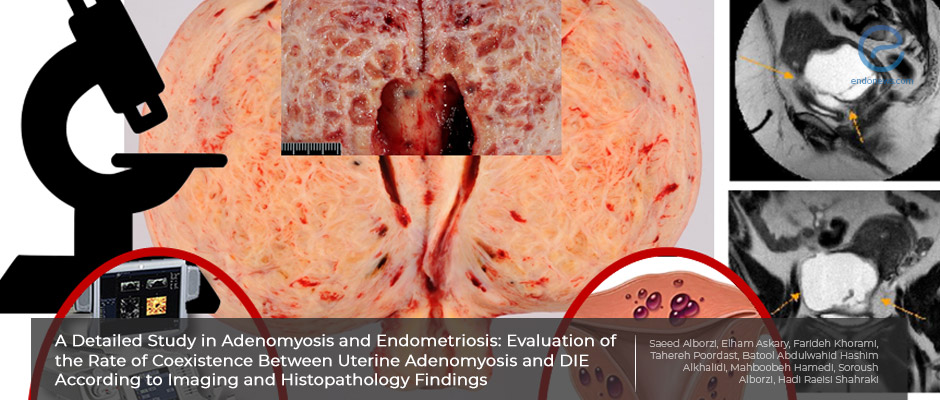Adenomyosis: accuracy of the diagnostic methods and the synchronism with deep infiltrating endometriosis
Apr 27, 2021
Transvaginal ultrasound is a sensitive, reliable first-line diagnostic tool for diagnosing adenomyosis, however, MRI is more specific.
Key Points
Highlights:
- There is no relation between adenomyosis, its subtypes, and deep infiltrating endometriosis. Transvaginal ultrasonography (TVU) is a sensitive diagnostic tool for adenomyosis diagnosis, however, MRI is more specific than TVU.
Importance:
- The pathophysiology of adenomyosis is unknown, several theories have been proposed for its incidence in multiparous and nulliparous women.
- There is a growing research interest owing to its relationship with endometriosis and even myoma, as well as the importance of their treatment in fertility preservation.
- The definition, diagnosis, and classification of adenomyosis are also not clear.
What's done here:
- Retrospective cross-sectional study conducted on 3725 patients with clinical symptoms that were indicative of endometriosis. 154 women with "endometriosis+adenomyosis", 68 with and 86 without hysterectomy, were evaluated.
- Synchronism of adenomyosis and different types of endometriosis including endometrioma and deep infiltrating endometriosis was examined.
- The accuracy, sensitivity, and specificity of imaging systems in the diagnosis of adenomyosis, pathology report being the gold standard, were also assessed.
- The findings of imaging modalities and microscopic pathologic features were compared.
Key Results:
- The accuracy, sensitivity, and specificity of TVU and MRI were 72.1%, 77.6%, 40%; and 49.2%, 41.5%, 90%, respectively.
- Transvaginal ultrasound (TVU) is a sensitive diagnostic tool for diagnosing adenomyosis, however, MRI is more specific than TVU in adenomyosis.
- There was no significant relationship between the presence or absence of adenomyosis and the presence of deep infiltrating endometriosis, and endometrioma.
- Regarding the association of different types of adenomyosis (focal and diffuse) with endometriosis, the diffuse type adenomyosis was more frequent in the absence of rectal and rectovaginal septum endometriosis.
Limitations:
- Lack of common nomenclature in describing the types of adenomyosis seems to be a major drawback.
- There is a lack of evaluation of asymptomatic patients and patients responding to medicines that have not undergone surgery.
- The absence of MRI in some patients, lack of subdivision of different subtypes of adenomyosis in histopathology reports could adversely affect the main results of this study.
Lay Summary
Dr. Alborzi and associates from Shiraz University of Medical Sciences, Iran, have published their comprehensive retrospective research conducted on 3725 patients with clinical symptoms of endometriosis over a period of 3 years, in "Reproductive Sciences" medical journal.
A relationship between endometriosis and adenomyosis has been suggested for years. Common pathophysiology for their simultaneous presence in the pelvis was sought in scientific papers. Adenomyosis basically is defined as the presence of endometrial glands and stroma within the myometrium which also involves hypertrophy and hyperplasia of the surrounding muscle cells resulting in focal or diffuse uterine enlargement. Based on their frequent associations, there is also a possibility for a common origin for adenomyosis and endometriosis.
The current study is a retrospective cohort study examining the patients who had both deep infiltrating endometriosis and adenomyosis diagnosed by imaging techniques. They were also confirmed with laparoscopic and surgical-pathological findings to detect the association between different endometriosis and adenomyosis types.
This retrospective cross-sectional study was conducted on 3725 patients with clinical symptoms that were indicative of endometriosis over a period of 3 years. Transvaginal ultrasonography (TVU) and/or MRI were performed and endometriosis diagnosis was confirmed. Based on pain symptomatology, conception desire, vital organ involvement, and no response to medical therapy, 870 patients underwent surgery. Finally, 154 endometriosis patients were included in the current study, 68 with and 86 without hysterectomy.
The accuracy of TVU in adenomyosis diagnosis was 72.1%, the sensitivity was 77.6%, and its specificity was 40.0%. The accuracy, sensitivity, and specificity of MRI for the diagnosis of adenomyosis in the same group were 49.2%, 41.5%, and 90.0%, respectively. These results suggest that TVU is a sensitive diagnostic tool for diagnosing adenomyosis. However, MRI seems to be more specific than TVU, in the case of junctional zone >12mm. is accepted as the cut-off value for adenomyosis.
There was no relationship between the presence or absence of adenomyosis and its subtypes, and endometriosis subtypes, however, adenomyosis was more prevalent in bilateral endometrioma.
The authors concluded that the proposal of posterior compartment endometriosis lesions invading the uterus and resulting in adenomyosis does not seem to be supported by these results obtained.
Research Source: https://pubmed.ncbi.nlm.nih.gov/33725313/
endometriosis adenomyosis imaging modalities TVS MRI histopathology MRI. ultrasonography accuracy sensitivity specificity

